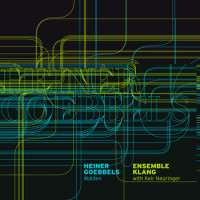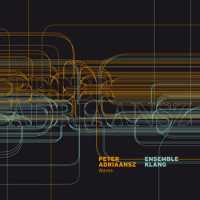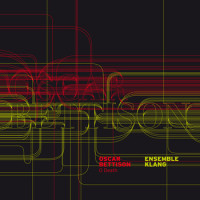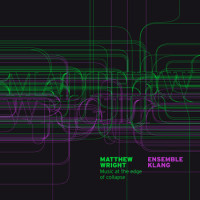Ensemble Klang’s Colors and Melodies
|
Grant Chu Covell [April 2014.] A prior Ensemble Klang release was mentioned before. The recent arrival of Goebbels’ Walden sparked revisiting a few albums.
Heiner GOEBBELS: Walden (1998/2008; arr. Pete HARDEN). Keir Neuringer (narrator, sax), Michiel van Dijk (reeds), Vera van der Bie, Maximilan Haft (vln), Max Knigge (vla), Esther Torrenga (vlc), Brice Soniano (cbs, electric bass), Ensemble Klang. Ensemble Klang Records EKR06 (1 CD) (http://www.ensembleklangrecords.com/). Thoreau took to the woods and wrote a book. Generally we take this to be the honorable act of a man keen to remove himself from society and rediscover himself in nature. Goebbels has a different take. Walden is about extracting oneself from society while remaining in plain sight. Where others might employ sounds of nature to reflect peaceful solitude, Goebbels creates an urban quasi-pop landscape with custom-made instruments. I’m inclined to agree with Goebbels’ perspective. Thoreau’s years in the woods were permitted by a degree of financial comfort. He could well afford to extract himself from everyday society and reclaim the wilderness. Of course, he was never that far away from Concord’s doings, and folks came to visit. This chamber arrangement reduced expressly for Ensemble Klang calls for speaker, two saxophones, trombone, percussion, piano/keyboard, guitar, string quartet and bass (alternating double and electric). Guest artist Keir Neuringer reads Thoreau’s words. We know that machines (trains) did intrude into Thoreau’s world, and so Goebbels incorporates electronics, samples and drones. Bird calls appear too, but they are imitated by people. The special percussion includes “steel cello” and “bow chimes” created by Bob Rutman, who collaborated with Goebbels on the piece. This is one bleak Walden. The work’s length and consistency are bound to inspire contemplation about unhealthy isolation. I pass through Concord on my daily commute and see the sign indicating the pond. I have a modern, tangible feel for Thoreau’s Walden. I imagine a loner in his cabin in the present, car lights shining through his windows, not to neglect car-boombox noise and ambulances.
Peter ADRIAANSZ: Waves 5-7 (2007); Nu descendant un Escalier (2008); Waves 11-13 (2008); Wave 3 (2007). Lisanne Soeterborek (vln), Juan Parra (electronics), Ensemble Klang. Ensemble Klang Records EKCD1 (1 CD) (http://www.ensembleklangrecords.com/). These installments in Adriaansz’s Waves series might initially suggest moving water or what permits us to see and hear. Whatever Adriaansz’s waves might be, they move slowly. Perhaps they’re being examined under magnification to reveal gritty details. Perhaps we’re panning across a landscape in slow motion, or perhaps someone’s playing with the volume of a music sample stretched to infinity. Tones near and far distort each others’ gravity. Perspective and lighting shifts expose wrinkles and chasms. The piece named after Duchamp’s painting is perfectly apt. Among the slow tones and glissandos, I was reminded of the introduction theme at the start of United Artists’ movies. The Klangers are appropriately strident in these bold and sometimes spooky pieces. You can marvel at each and every detail. Each piece is recorded in a single take without overdubbing or editing. Kudos to the Ensemble and recordists Tom Gelissen and Lauran Jurrius.
Oscar BETTISON: O Death (2005-07, rev. 2009). Ensemble Klang. Ensemble Klang Records EKCD3 (1 CD) (http://www.ensembleklangrecords.com/). A lone trombone strolls into O Death with a bluesy tune, and just like that we’ve crossed a threshold. Do these seven movements form a requiem or is it a wake we’ve stumbled upon? Movement titles are derived from antiquated or popular folk texts: “Take leave of carnal vain delight,” “I believe I’m sinking down,” etc. The off-road instrumentation blends saxophones, clarinets and recorders up top, supported with guitars, banjo, jaw’s harp, all nature of percussion, keyboards, electronics and tape. This continually varying roster leads to complex sounds to which Ensemble Klang provides vivid life. Sometimes repeated jazz or pop chords pound incessantly only to trail away leaving a forlorn melody. It’s an unpredictable one-way journey.
“Music at the edge of collapse.” Matthew WRIGHT: Totem for Den Haag (2010); Nocturne for BJM (2004); Music in the Shape of ELEVEN (2008); Ithaca Blog (2010); Entanglement Laws (2006); Statis i – iv (2010). Matthew Wright (turntables, voice, electronics), Niels Meliefste (keyboards), Heledd Francis Wright (fl, voice), Ensemble Klang. Ensemble Klang Records EKCD4 (1 CD) (http://www.ensembleklangrecords.com/). Wright’s Totem proceeds according to a pattern which, for convenience, we can designate as accrued minimalism. Instruments play distinct, simple notes or gestures at their own rate; the total sound mass phases gradually across different regions and moods. Klang’s constituents (electric guitar, piano, percussion, saxophones, trombone, with samples brought in on computer) are each rendered clearly across the stereo field. The piano and saxophone’s different timbres are precisely distinctive. Intruding electric guitars create a strong haze as all else pierces through. In Entanglement Laws different materials move at different rates. Nocturne might suggest a more conventional melody plus accompaniment, except for the frantically bubbling saxophone ignoring the slow-moving accents from percussion and guitars over a slow vocal wash. Music in the Shape of ELEVEN utilizes the same methods (the score’s measures are bricks arranged to form an E, L, E, V, E and N), with a flute contributing to the treble texture. Ithaca Blog constructs shapes for a solo saxophone involving atomic repetition and realtime manipulation. The pieces are interleaved with the Statis series that tells small stories. Ensemble Klang’s players and a fine recording ideally portray Wright’s music. I’m sure collaboration with another group might have led to an indistinct mush. * * * Ensemble Klang:
[More Grant Chu Covell]
[Previous Article:
Personal Discoveries: Mieczysław Weinberg]
[Next Article:
Of Light through the Clouds]
|



